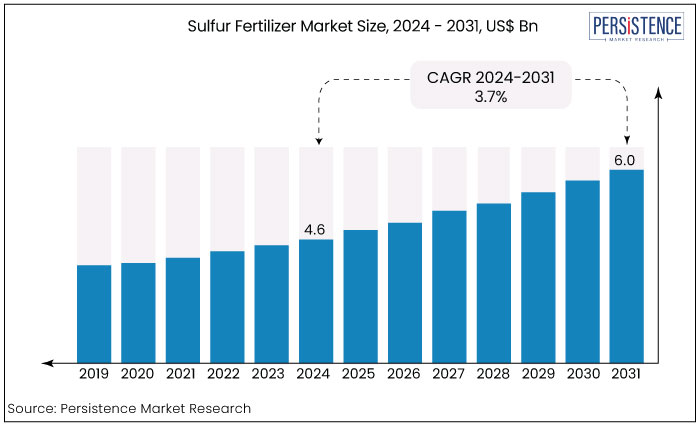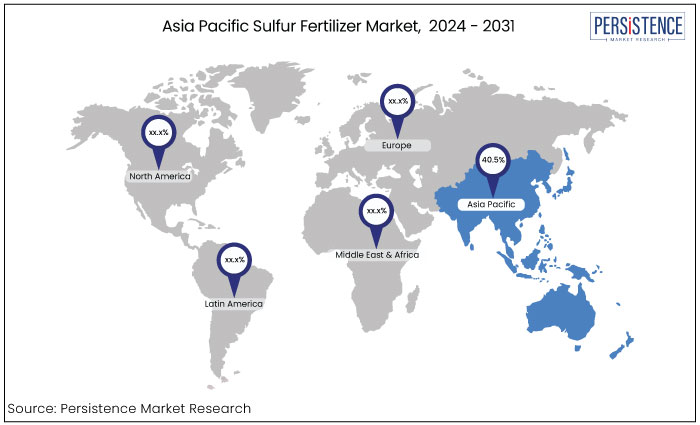Sulfur Fertilizer Market
Industry: Chemicals and Materials
Published Date: September-2024
Format: PPT*, PDF, EXCEL
Delivery Timelines: Contact Sales
Number of Pages: 168
Report ID: PMRREP34802
The sulfur fertilizer market is estimated to increase from US$4.6 Bn in 2024 to US$6.0 Bn by 2031. The market is projected to record a CAGR of 3.7% during the forecast period from 2024 to 2031. The sulfur fertilizer market is flourishing driven by rising sulfur shortages in soil, heightened agricultural practices, and a surging need for crops like canola that lack sulfur. This trend is further propelled by the quest for enhanced agricultural yields.

Key Highlights of the Market
|
Attributes |
Key Insights |
|
Market Size (2024E) |
US$4.6 Bn |
|
Projected Market Value (2031F) |
US$6.0 Bn |
|
Global Market Growth Rate (CAGR 2024 to 2031) |
3.7% |
|
Historical Market Growth Rate (CAGR 2019 to 2023) |
1.4% |
|
Region |
Market Share in 2024 |
|
Asia Pacific |
40.5% |
Asia Pacific market is expected to account for 40.5% market share in 2024. As the largest producer of agricultural commodities, it is expected to contribute significantly to global agricultural output.
The region faces increasing fertilizer demand due to a growing population and decreasing arable land. Leading countries in the market are China and India, which are the significant contributors to the rising need for fertilizers, including sulfur-based options. It is driven by their extensive agricultural activities and the necessity to enhance crop yields.

North America market is witnessing significant growth due to players' heightened research and development investments and increased sulfur adoption in applications like phosphate fertilizers. The region's robust agricultural sector and rising fertilizer demand in the United States and Canada fuels the need for sulfur fertilizers.
North America's emphasis on boosting production to meet global sulfur demand significantly contributes to market growth. This combination of factors positions the region for continued expansion in the sulfur fertilizer sector as it adapts to evolving agricultural needs.
|
Category |
Market Share in 2024 |
|
Form - Liquid |
78.3% |
Liquid form of sulfur fertilizers is predicted to account for around 78.3% of revenue in 2024. These liquid formulations are available as solutions or suspensions facilitating quick plant uptake when applied as foliar sprays or soil drenches. Their rapid assimilation makes them ideal for addressing deficiencies during critical growth phases.
Liquid sulfur fertilizers offer versatile application methods, enabling precise and targeted nutrient delivery to enhance crop performance effectively.
|
Category |
CAGR through 2031 |
|
Type - Sulfates |
2.56% |
Sulfates have conquered the industry in past years and are projected to expand significantly in the sulfur fertilizer market, achieving a CAGR of 2.56% through 2031. Ammonium sulfate, containing 24% sulfur is a popular choice due to its rapid absorption by plant roots making it ideal for crops requiring immediate nutrient uptake.
Gypsum, a form of calcium sulfate, offers the dual advantage of supplying sulfur and calcium, enhancing soil structure, and improving overall crop quality. This growing preference for sulfate fertilizers reflects their effectiveness in meeting agricultural demands.
The market overview has shown significant growth in recent years and is expected to grow further. Sulfur fertilizers are essential agricultural inputs that provide sulfur, a vital macronutrient for plant growth.
Defined as fertilizers containing sulfur in various forms such as elemental sulfur, sulfate, or thiosulfate, these products play a critical role in enhancing soil fertility and crop yield. The industry has experienced significant growth in recent years driven by increasing awareness of the importance of sulfur in agricultural productivity and the rising demand for food globally.
A key trend in the market is the heightened focus on sustainable agriculture practices. Farmers are increasingly adopting these fertilizers as part of integrated nutrient management systems to improve soil health and reduce the reliance on synthetic fertilizers. This shift is further propelled by government regulations promoting environmentally friendly farming practices, which encourage the use of natural fertilizers.
Some other sulfur fertilizer market trends including precision agriculture, are gaining traction. Advanced technologies such as soil testing and nutrient management software are being used to optimize the application of sulfur fertilizers. This allows farmers to apply the right amount of sulfur at the right time, enhancing efficiency and reducing environmental impact.
As the agricultural sector continues to evolve, innovations in sulfur fertilizer formulations and application methods are expected to shape the future of the market ensuring the sustainable growth of crops while maintaining soil health.
The sulfur fertilizer market analysis has witnessed a steady growth trajectory over the past few years, with an annual growth rate of 1.4% from 2019 to 2023. This growth can be attributed to several factors, including the increasing recognition of sulfur's role in enhancing crop yields and soil health and the rising global population demanding higher agricultural output.
During this period, the market has also benefited from agricultural advancements and technologies promoting efficient nutrient management. The industry is poised for a strong expansion, with projections indicating a growth rate of 3.7% from 2024 to 2031. This anticipated acceleration is driven by several key trends.
The growing emphasis on sustainable agriculture and environmentally friendly farming practices is expected to boost the demand for these fertilizers, as they are essential for maintaining soil fertility without the adverse effects associated with synthetic fertilizers. Additionally, the increasing adoption of precision agriculture techniques will enable farmers to optimize sulfur application, further enhancing crop productivity.
The rising trend of organic farming is expected to contribute to several market opportunities as more farmers seek natural sources of sulfur to meet the nutritional needs of their crops. As the agricultural landscape continues to evolve, the market is set to play a crucial role in supporting global food security while promoting sustainable farming practices.
Increasing Soil Sulfur Deficiencies
One of the primary growth drivers for the sulfur fertilizer market expansion is the rising incidence of sulfur deficiencies in agricultural soils. As modern farming practices often focus on nitrogen and phosphorus, sulfur levels can diminish over time leading to reduced crop yields and quality. This deficiency has prompted farmers to seek sulfur fertilizers to replenish soil nutrients, ensuring optimal plant growth.
The awareness of sulfur's critical role in enhancing crop health and productivity is driving demand for these fertilizers, making it a significant factor in market expansion.
Rising Demand for Sustainable Agriculture
The global shift toward sustainable agriculture is another key driver for sulfur fertilizer market demand. As consumers and governments increasingly prioritize environment-friendly farming practices, the demand for natural and organic fertilizers including sulfur-based products is on the rise.
Sulfur fertilizers not only improve soil health but also contribute to sustainable crop production by reducing the reliance on synthetic fertilizers. This trend is encouraging farmers to adopt integrated nutrient management strategies, further boosting the market for sulfur fertilizers as they seek to enhance sustainability in their operations.
Technological Advancements in Fertilizer Application
Technological advancements in agriculture, particularly in precision farming, are significantly influencing the sulfur fertilizer market growth. Innovations such as soil testing, nutrient management software, and variable rate application technologies allow farmers to apply sulfur fertilizers more efficiently and effectively.
Technologies enable precise nutrient management, ensuring that crops receive the right amount of sulfur at the right time, which enhances productivity and minimizes waste. As farmers increasingly adopt these technologies, the demand for sulfur fertilizers is expected to grow, driving market expansion in the coming years.
High Production Costs
One significant factor impeding sulfur fertilizer market sales is the high production costs associated with sulfur fertilizers. The extraction and processing of sulfur can be expensive, particularly when considering the energy-intensive methods required for its conversion into usable forms.
Fluctuations in the prices of raw materials and energy can further increase production costs. These elevated expenses can deter farmers from investing in sulfur fertilizers, especially in regions where profit margins are tight. Consequently, this financial barrier can limit market growth and adoption rates among agricultural producers.
Regulatory Challenges
Another factor hindering the sulfur fertilizer market revenue is the complex regulatory environment surrounding fertilizer use and application. Governments worldwide are increasingly implementing stringent regulations aimed at minimizing environmental impacts from agricultural practices.
Regulations can include restrictions on the types and amounts of fertilizers that can be applied, as well as requirements for environmental assessments. Navigating these regulations can be challenging for farmers and fertilizer manufacturers alike, potentially leading to delays in product availability and increased compliance costs. Such regulatory hurdles can stifle innovation and slow market growth in the sulfur fertilizer sector.
Expansion of Organic Farming Practices
As global demand for organic produce continues to rise, there is a significant opportunity for the market to expand within the organic farming sector. Organic farmers often seek sustainable nutrient sources that enhance soil health while meeting regulatory standards.
Sulfur fertilizers particularly those derived from natural sources align well with these needs. By developing and promoting organic-certified sulfur fertilizers, manufacturers can tap into this growing market segment providing essential nutrients to crops while catering to the increasing consumer preference for organic products.
Innovations in Fertilizer Technology
The sulfur fertilizer market concentration report states that the industry is poised for growth through innovations in fertilizer technology. Advancements in slow-release and controlled-release sulfur formulations can enhance nutrient efficiency and reduce environmental impacts. These innovative products allow for precise application ensuring that crops receive optimal sulfur levels throughout their growth cycles.
Integrating sulfur fertilizers with digital agriculture solutions, such as precision farming tools and data analytics, can improve application strategies. By investing in research and development of these technologies, companies can capture new market opportunities and drive sustainable agricultural practices.
The market is characterized by intense competition among key players striving to innovate and capture market share. Companies like Nutrien Ltd. have introduced innovative products such as Nutrien's Sulfur Enhanced Urea, launched in 2022, which combines nitrogen with sulfur to improve nutrient efficiency in crops. This innovation reflects a growing trend toward precision agriculture, with firms focusing on sustainable solutions that enhance crop yields while minimizing environmental impact, thus shaping the competitive landscape.
Recent Developments in the Sulfur Fertilizer Market
|
Attributes |
Details |
|
Forecast Period |
2024 to 2031 |
|
Historical Data Available for |
2019 to 2023 |
|
Market Analysis |
US$ Billion for Value |
|
Key Country Covered |
|
|
Key Market Segments Covered |
|
|
Key Companies Profiled |
|
|
Report Coverage |
|
|
Customization & Pricing |
Available upon request |
By Type
By Form
By Region
To know more about delivery timeline for this report Contact Sales

The market is predicted to rise from US$4.6 Bn in 2024 to US$6.0 Bn by 2031.
Yara International, Nutrien Inc, The Mosaic Company, ICL, and Nufarm Limited are some of the leading players operating in the market.
A promising opportunity lies in the innovations in fertilizer technology.
Asia Pacific is the dominant regional market and to hold 40.5% market share in 2024.